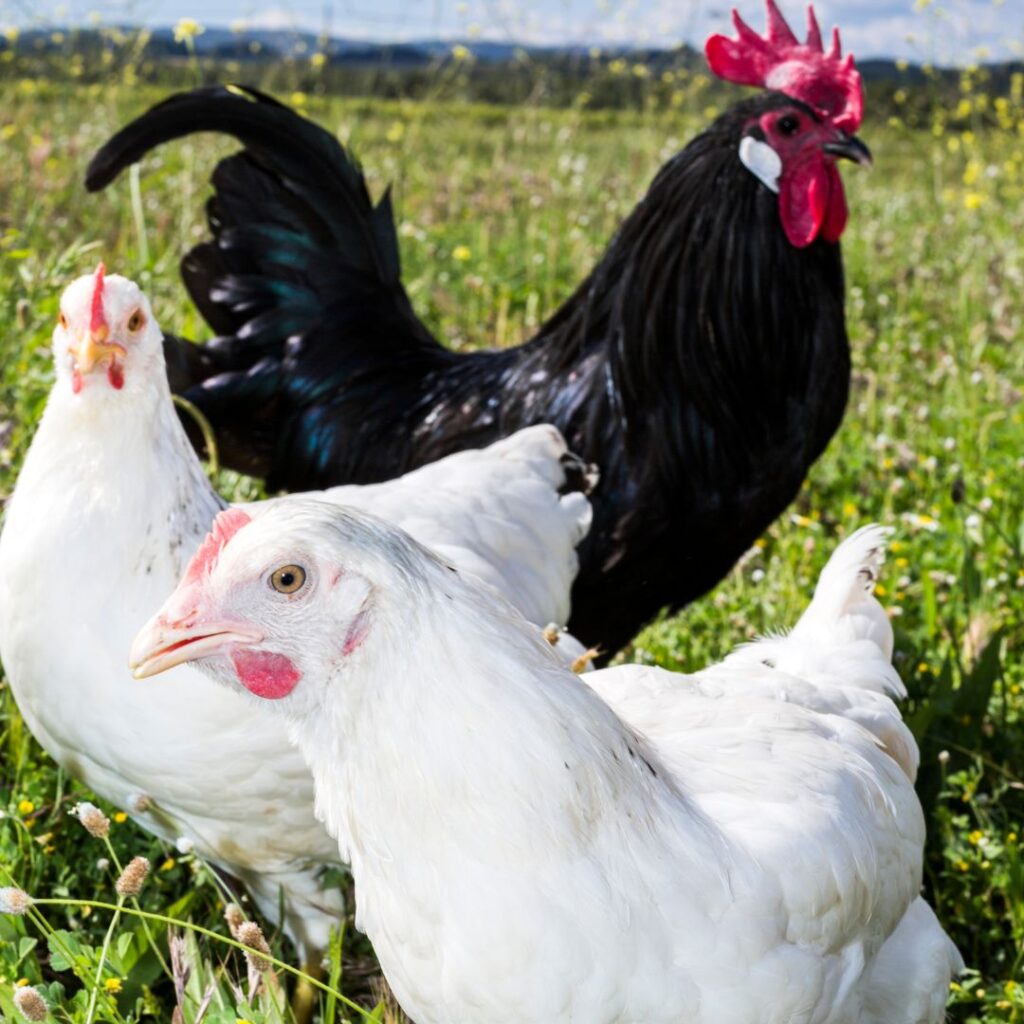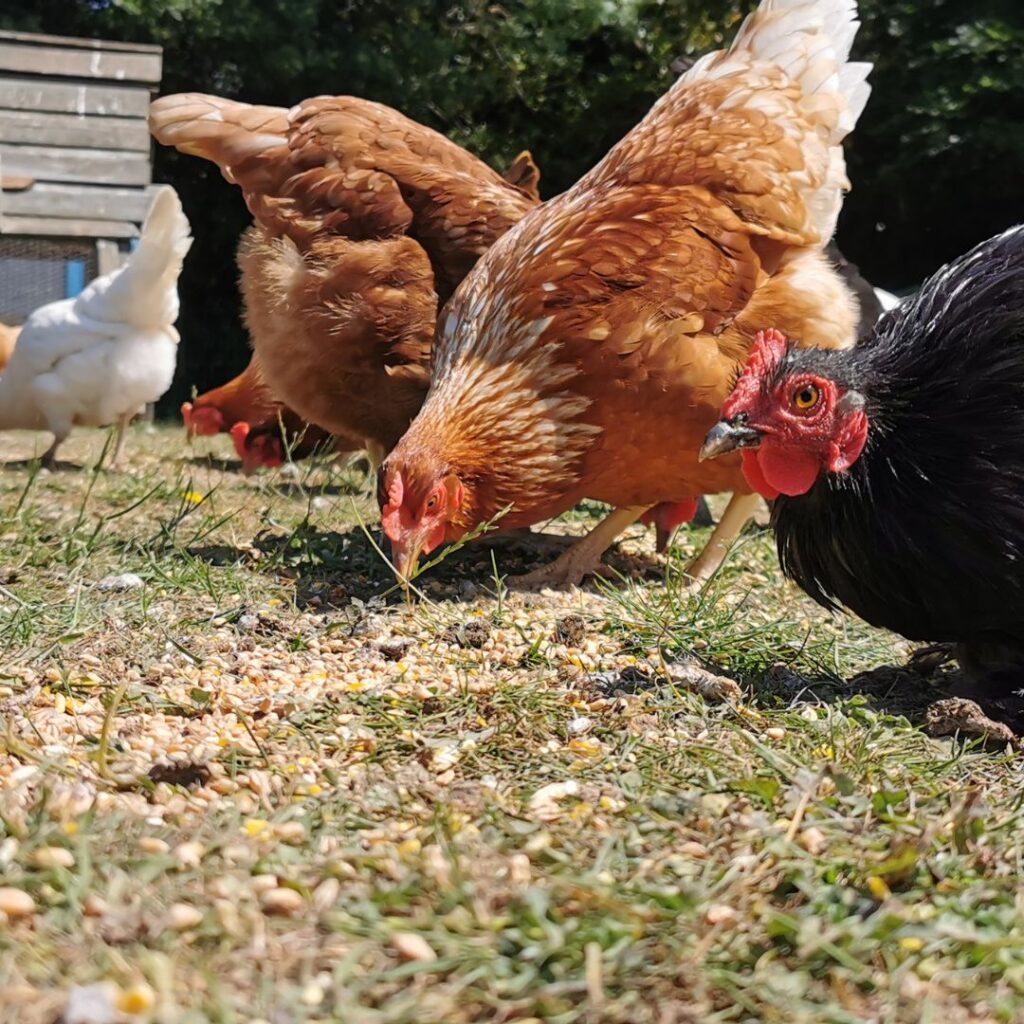Did you know that summer is more challenging for chickens than winter? That’s why you want to know more about heat-hardy chickens if you live in hot parts of the U.S., like Florida, Arizona, Texas, and other heat-prone areas.
Here in New England, we are prone to heat waves, so we’re always looking for chickens that do well in hot and cold climates.
Here’s what we’ll cover in this article: what breeds do best and worst in hot climates? How to spot signs of heat stress, how to help your chickens stay cool, what chicken breeds to avoid in hot climates, feed considerations, and more for heat tolerant chickens.
What Makes for a Heat Hardy Chicken?
There are a handful of things that make a chicken heat hardy. These are some primary things to look for when picking a breed (or hybrid) to add to your flock in warm climates.

Ancestry/ Origin
Mediterranean breeds, certain hybrids with Mediterranean parentage, are sure indicators of a heat-hardy chicken. Although, as you’ll see, not only are Mediterranean breeds heat-tolerant chickens, but many more are.
Physical Characteristics
Picking a heat-tolerant chicken breed can be made more accessible by looking for specific characteristics in your breed.
Most hatcheries will let you know whether or not the chicken breed is suitable for hot and cold climates in their descriptions.
Combs and Wattles – Chickens with larger combs and wattles are better equipped to beat the heat.
Their natural characteristics allow them to regulate their body temperature very efficiently. This is made possible by the blood vessels in their combs and wattles, which contain many capillaries.
These tiny blood vessels circulate both body heat and blood close to the skin’s surface, where the heat is released out of the combs and wattles.
Feather Colors – Just like dressing for warm weather, light colors reflect light better, whereas dark colors absorb heat. Lighter feather colors do better in a hot climate.
When choosing breeds, if they have lighter feather color choices, consider a ‘white’ or ‘buff’ color for your flock.
Body Fat and Size – Chickens with smaller body mass have a higher surface area to body weight ratio, which helps keep them cool in hot weather.
Selecting a chicken with less body fat is much easier to maintain and cool in hot weather.
A smaller body mass helps the chicken regulate its body temperature more efficiently in hot weather, so it does not overheat.
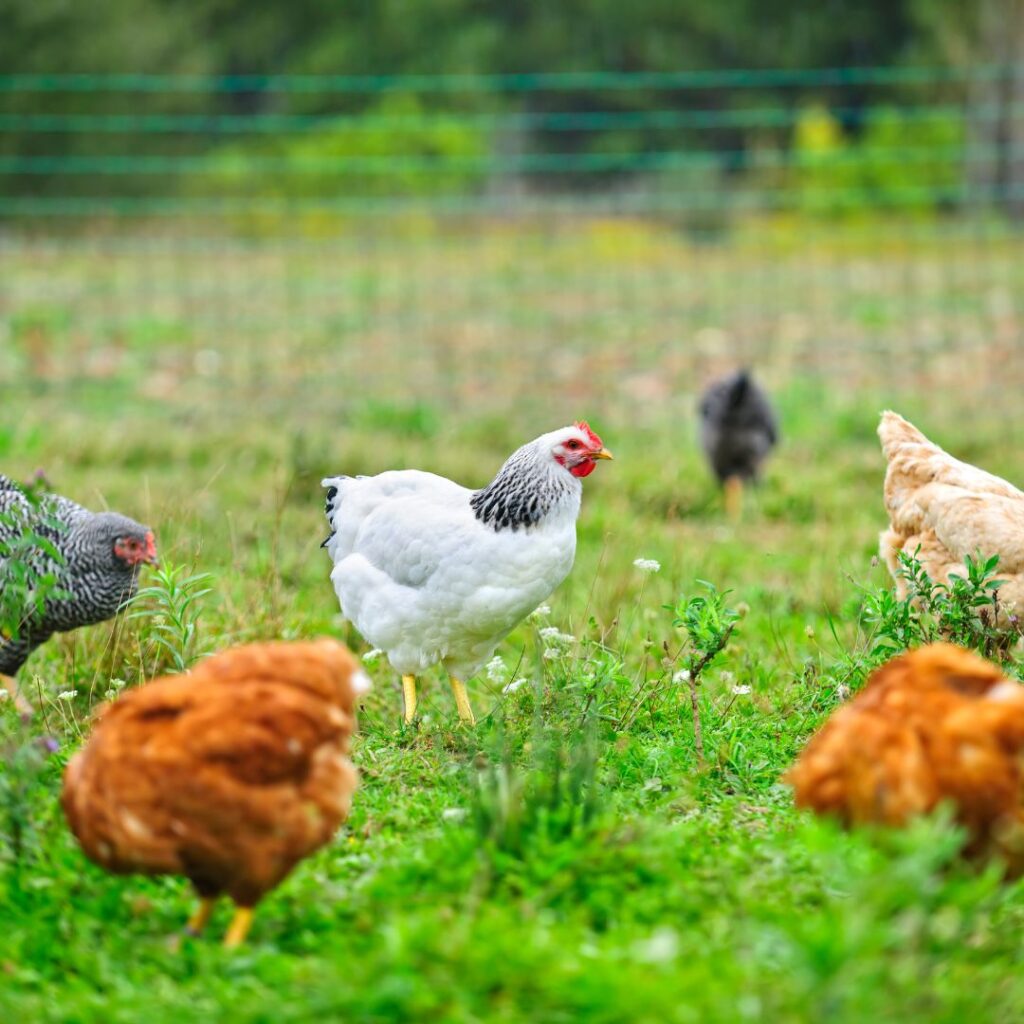
What Is The Ideal Temperature For Chickens
Keeping your chickens cozy and comfortable is critical to their health and overall well-being. Even the best heat-tolerant chickens prefer temperatures between 55-75 degrees Fahrenheit.
Sudden temperature increases (heat waves) above 80 – 90 degrees add stress to the chicken’s body systems and could be fatal.
It is important to note that it isn’t just the temperature alone but also the humidity level that affects the comfort levels of chickens. Humidity levels can cause extreme stress on the respiratory system of your flock.
It is wise to look into methods of cooling down the air and your flock during hotter months of the year for their safety, well-being, and survival.
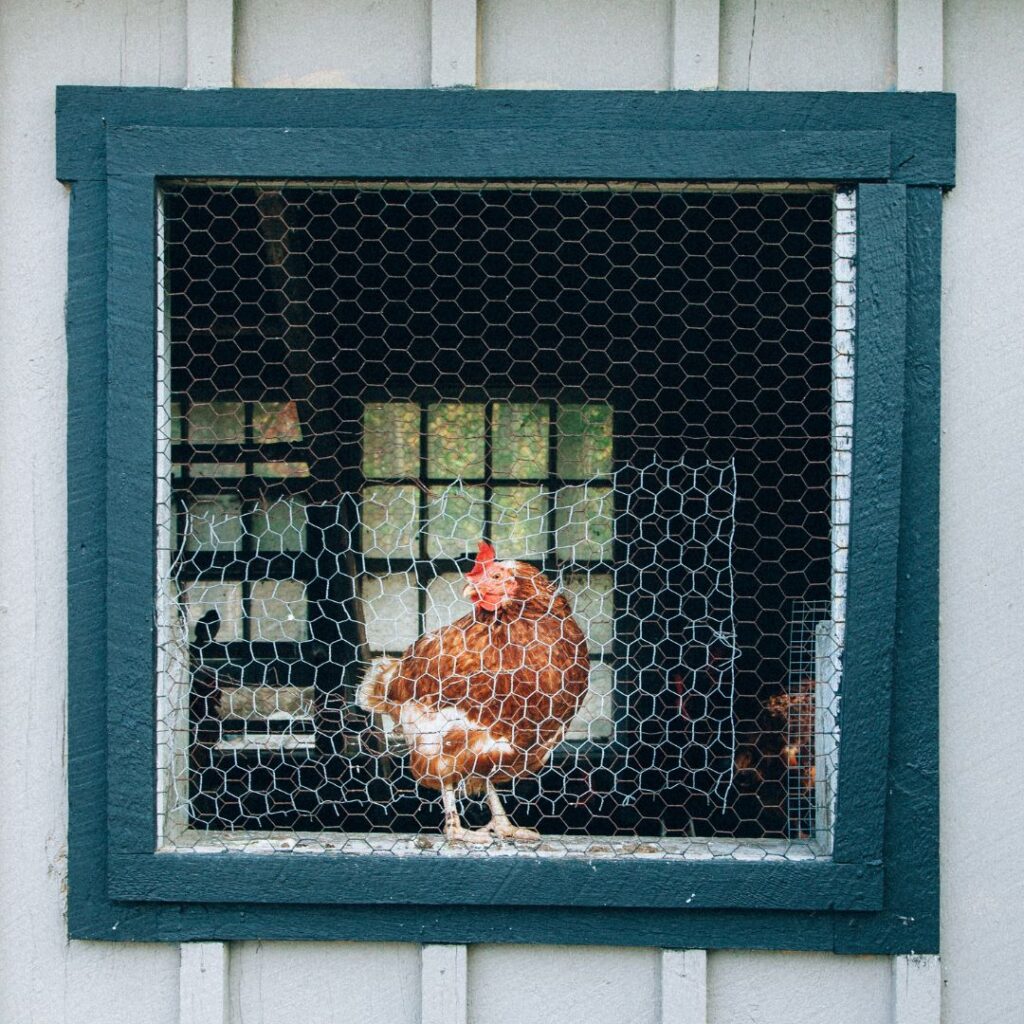
15+ Chicken Breeds That Can Survive Hot Climates
We’ve compiled a list of the most popular heat-hardy chicken breeds for backyard chickens and know you’ll love the variety in egg-laying chicken breeds, hybrids, and egg color varieties.
Caution: even though these chicken breeds and hybrids are tough birds in enduring warm climates, you still need to be watchful for signs of heat stress.
Be sure to read about beginner tips for raising chickens.
Araucana

- Origin – Chile
- Recognized by American Poultry Association (APA) – Yes
- Comb type – Pea Comb
- Size – Hen -4 lbs, Rooster – 5 lbs
- Eggs – Lay eggs that are blue, size; 150-200 per year
- Personality – This chicken breed is chatty but not loud. They are known to be unpredictable, with some very calm and docile and others flighty.
Ameraucana
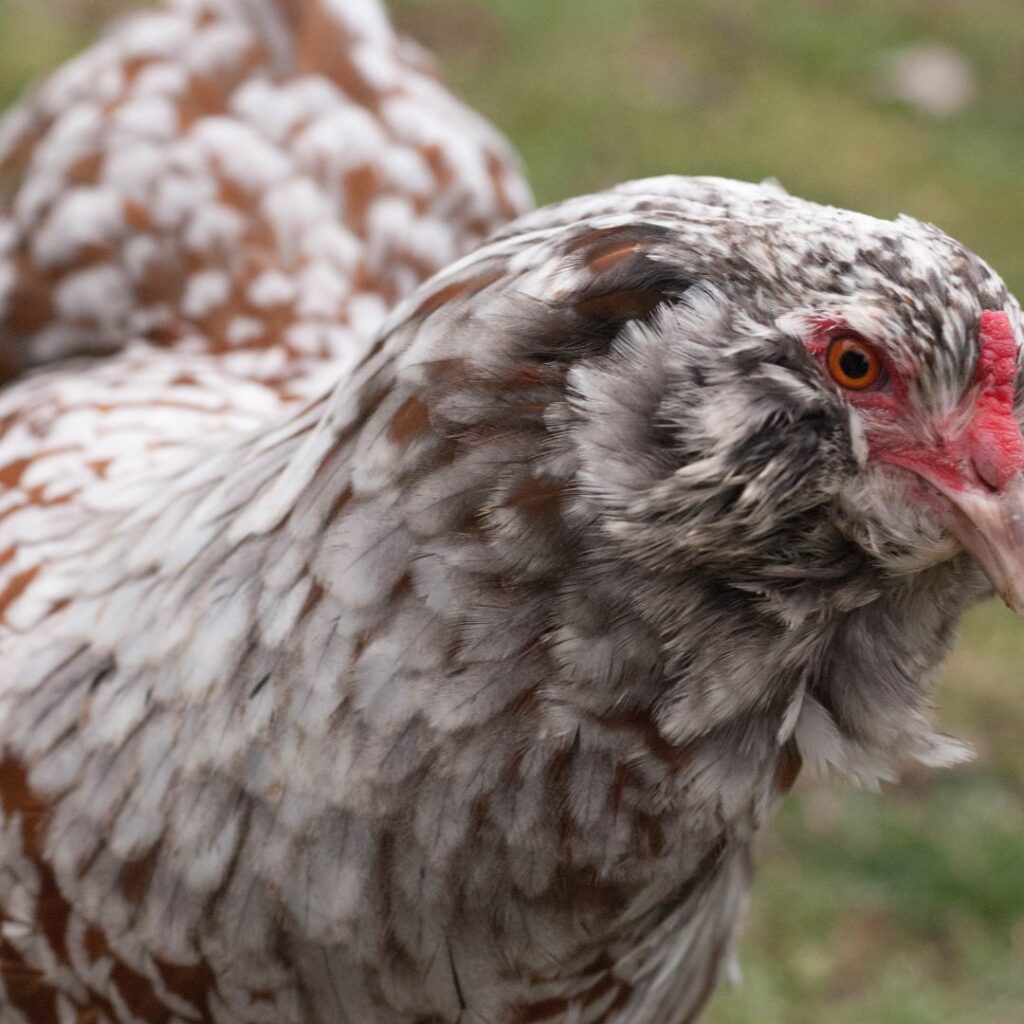
- Origin – As the name implies, the Ameraucana is an American chicken breed. This breed was developed in the United States in the 1970s and emanated from Araucana chickens from Chile.
- Recognized by APA – Yes – 1984
- Comb type – Pea comb
- Size – Hen – 5 1/2 lbs, Rooster – 6 1/2 lb
- Eggs – Blue, Medium-Large, 180-200 eggs per year
- Personality – Adventurous, friendly, docile, quiet
Ameraucana chickens heat tolerance is pretty good, considering it’s not a Mediterranean breed. Of course, as with any chicken, providing shade steady supply of cool, fresh water is essential.
Brahma
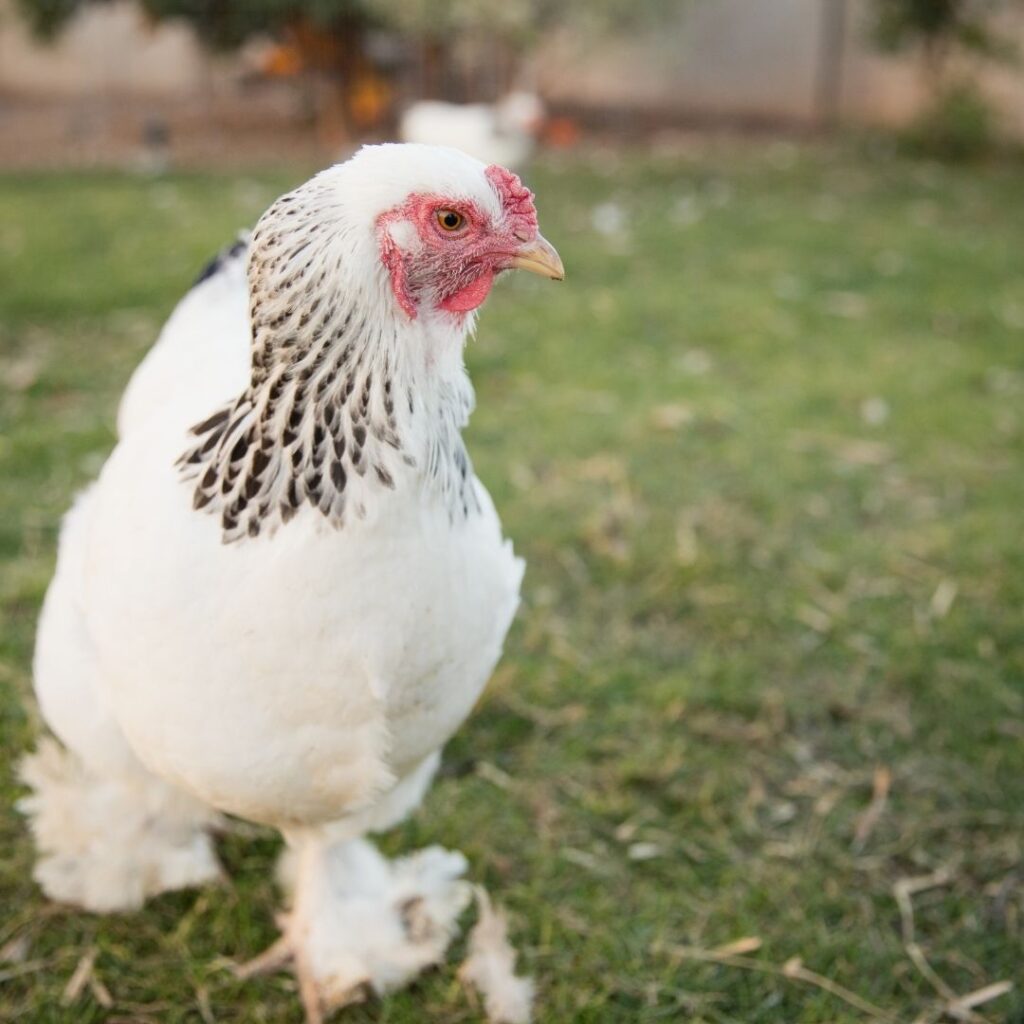
These Gentle Giants are grand in appearance and will generously provide about three-four eggs a week and can be raised for meat purposes.
- Origin- Asiatic Class- The Brahma is an American breed of chicken that was developed in the United States. with birds from the Chinese port of Shanghai.
- Recognized by APA – Yes – 1874
- Comb type – pea
- Size – Hens – 9 1/2 lbs, Roosters – 12 lbs
- Eggs – Large, brown, 180-240 eggs per year
- Personality – Gentle, friendly, docile, excellent as a pet chicken
Barred Plymouth Rock
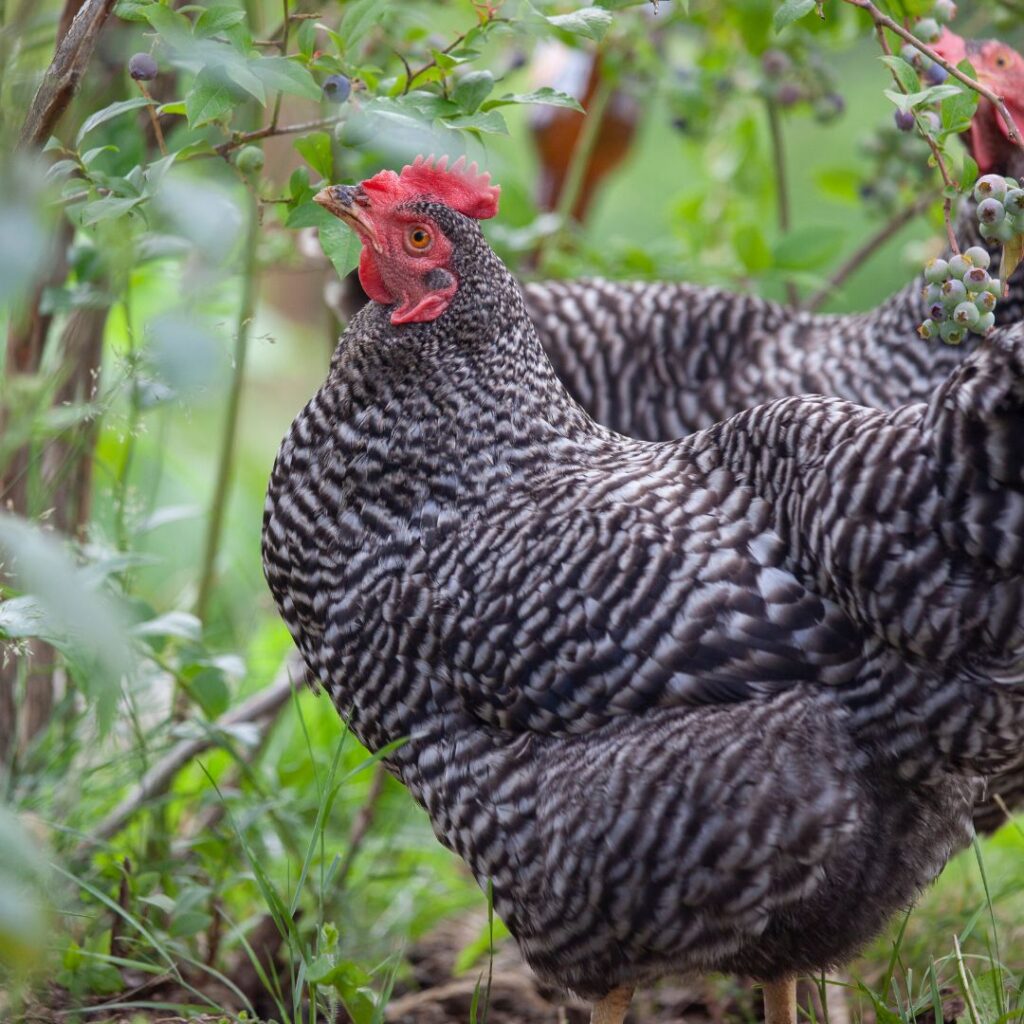
As you may have guessed, the Plymouth Rock chickens were introduced to the U.S. by early settlers and are known to be one of the first few breeds recognized in the states by the APA.
Early on, these birds were raised for eggs as well as their tasty meat. They’re still considered a desirable dual-purpose bird today.
- Origin – American
- Recognized by APA – Yes – 1874
- Comb type – Single
- Size – Hen – 7 1/2 lbs, Rooster – 9 1/2 lbs
- Eggs – Large, Brown, 200 – 280 eggs per year
- Personality – Quiet, friendly, playful, tolerates being handled, good family pet
Cream Legbar
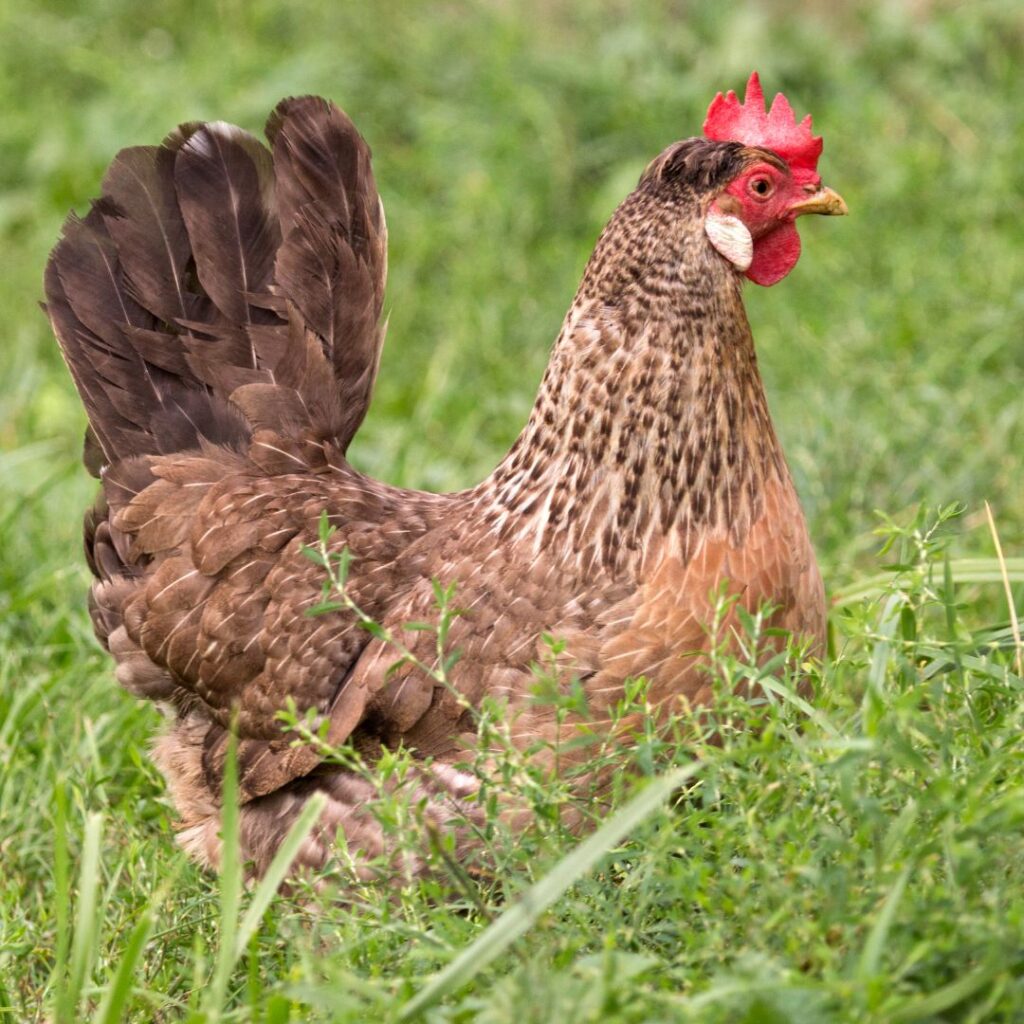
- Origin – Britain
- Recognized by APA – No – (more on the status here with the Cream Legbar Club)
- Comb type – Single
- Size – Hen – 5 lbs, Rooster – 6 lbs
- Eggs – Medium, Blue, 180-200 eggs per year
- Personality – Can be a bit vocal, friendly, easy-going
Delaware

- Origin – American – United States, Delaware
- Recognized by APA – Yes – 1952
- Comb type – Single
- Size – Hen – 6 1/2 lbs, Rooster – 8 1/2 lbs
- Eggs – Extra Large, Brown, 175-250 eggs per year
- Personality – Chatty, loud, friendly, curious, independent
Easter Egger
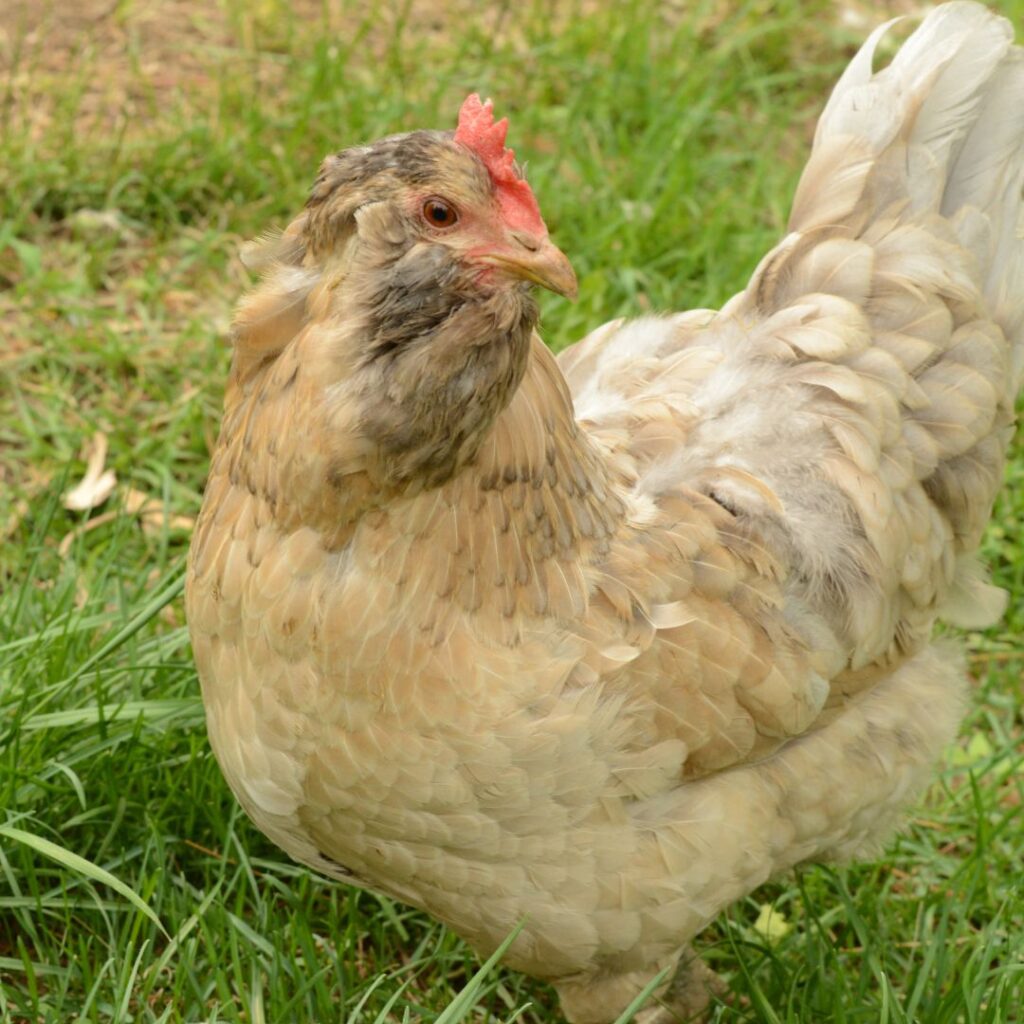
Easter egger chickens are certainly the most colorful of breeds for hot weather. Not only do the hens lay multicolored eggs, but their feather patterns and colors also vary, making for a colorful flock,
- Origin – United States with parentage from Chile and other breeds
- Recognized by APA – No, this is a ‘designer’ breed, hybrid chicken.
- Comb type – Pea, Rose, Single
- Size – Hen – 5 1/2 lbs, Rooster – 6 1/2 lb
- Eggs – Medium-Large, Green/ Olive Green, Blue, Pink, occasional brown egg, 200-280 eggs per year
- Personality – These are one of the sweetest chickens, docile, social, excellent family pet
Golden Comet, aka Cinnamon Queen
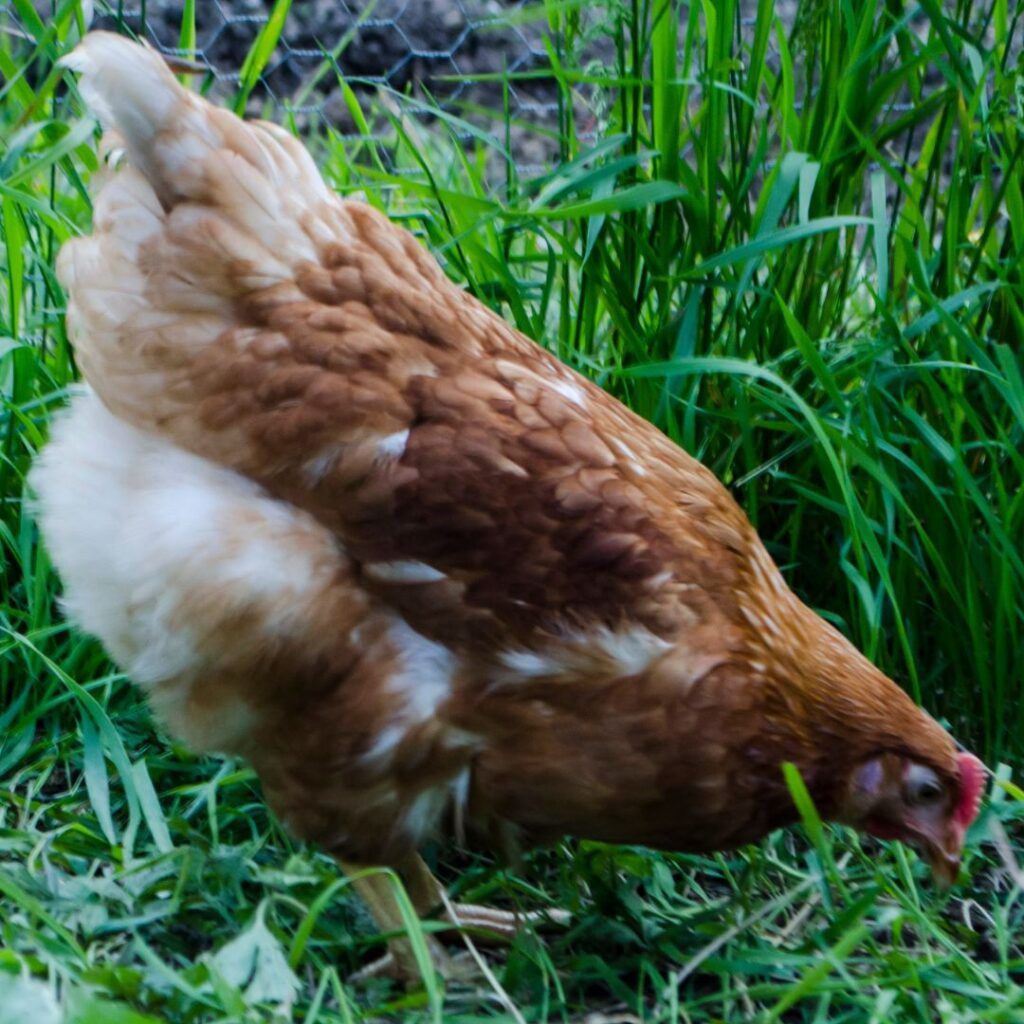
This productive egg layer is known for being one of the most gentle birds. They’re a hybrid developed with peak egg productivity in mind. They genuinely are poultry’ gold’.
- Origin – United States
- Recognized by APA – No, this is a hybrid chicken developed with various breeds like the New Hampshire Reds, RI Reds, RI Whites, Cherry Eggers, White Rock, or even the Silver Laced Wyandotte.
- Comb type – Single
- Size – Hen – 6-7 lbs, Rooster – 8-9 lbs
- Eggs – Large- Xlarge, Brown, 280-320
- Personality – Quiet, Active, Mellow, Friendly, Great pet chicken
Naked Neck aka Turken

These quirky-looking birds have 40% fewer feathers than most, making them unique in appearance and one of the very best chicken breeds for hot weather.
The naked neck is also a fantastic dual-purpose bird if you want to raise chickens for meat and eggs.
- Origin – East Hungary, Romania (thus the Transylvanian chicken nickname)
- Recognized by APA – Yes – 1965
- Comb type – Single
- Size – Hen – 6 1/2 lbs, Rooster – 8 1/2 lb
- Eggs – Large, Brown, 180-240 per year
- Personality – Very friendly, social, and active. Known as ‘goofballs’ in the chicken world, you can expect some comedians in the flock.
New Hampshire Red
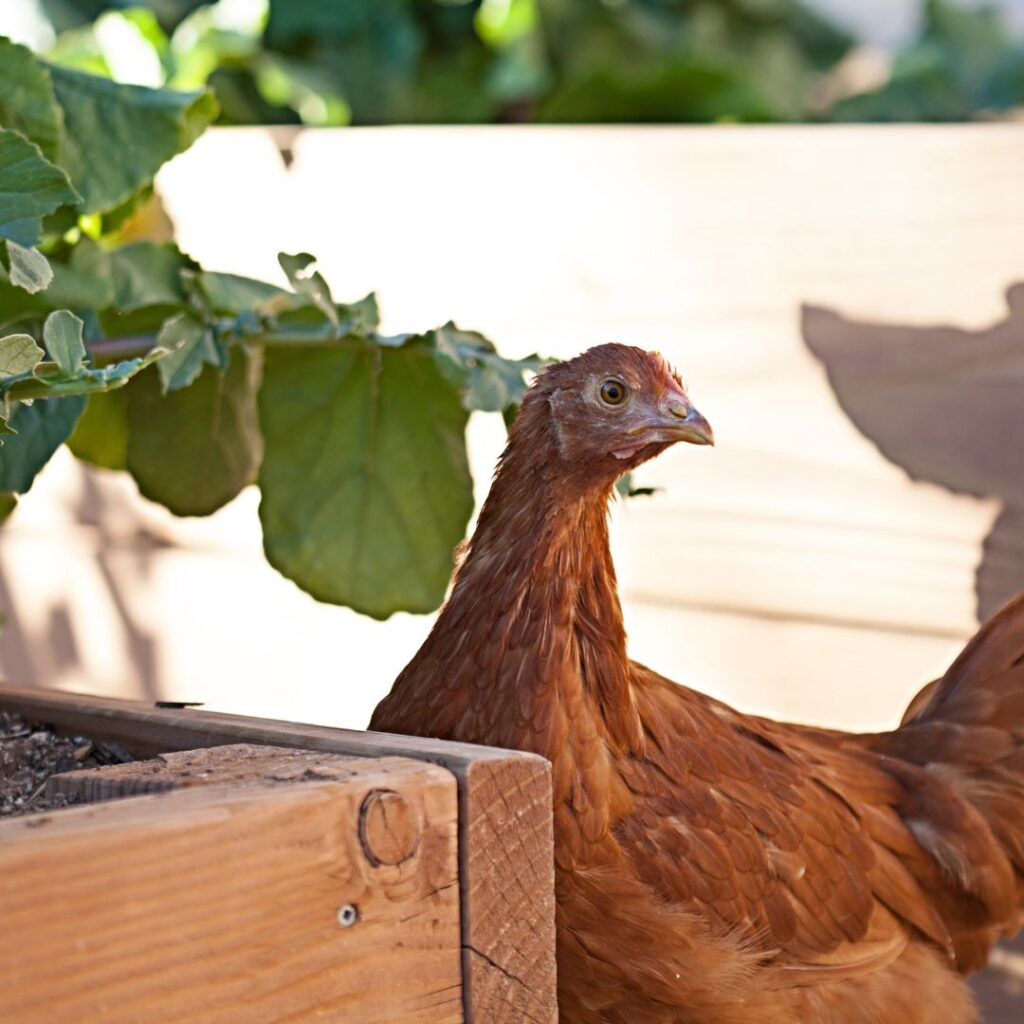
- Origin – American – United States – New Hampshire and R.I.
- Recognized by APA – Yes, 1935
- Comb type – Single
- Size – Hen – 6 1/2 lbs, Rooster – 8 1/2 lbs
- Eggs – Large-Extra Large, brown, 200-280 eggs per year
- Personality – Varies from friendly and curious to aggressive and territorial. They can be more assertive with hen pecking as they are near the top of the pecking order.
Olive Egger
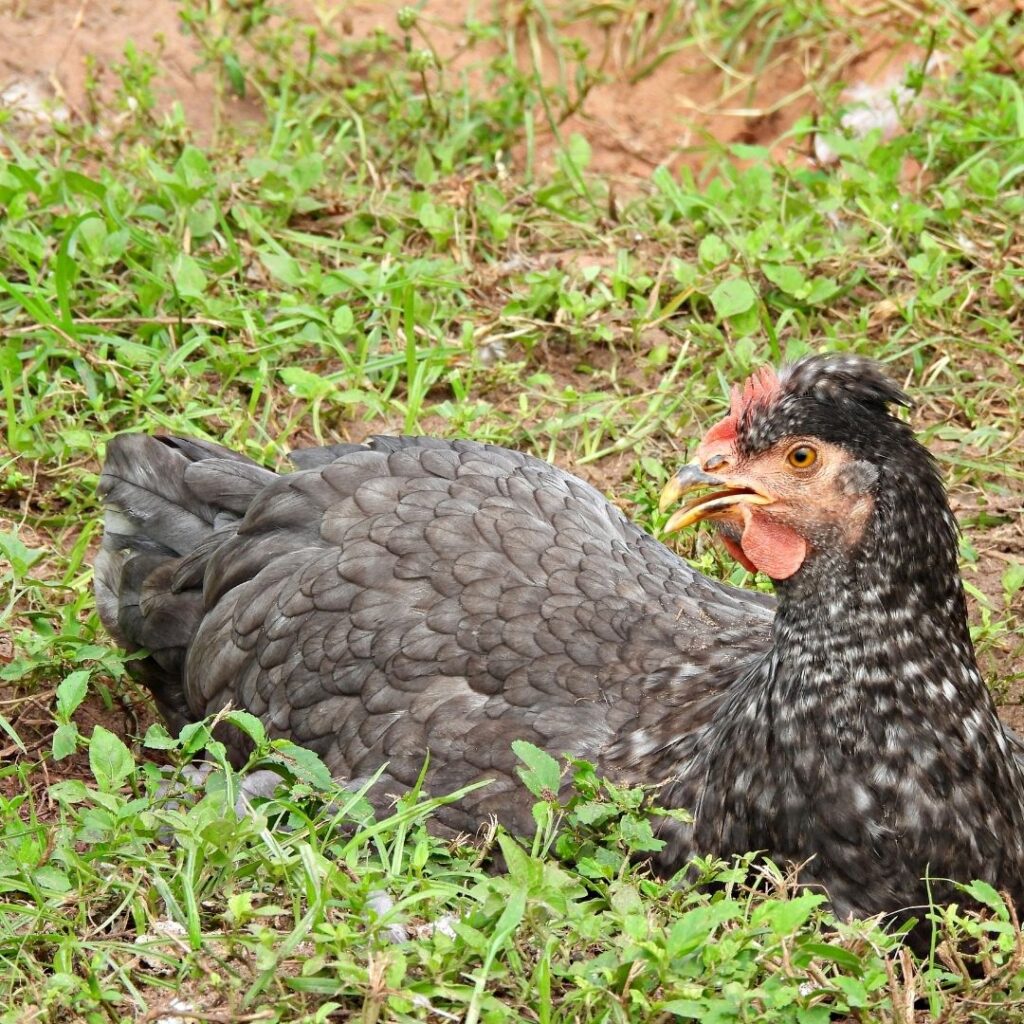
This is one of the few green egg-laying chicken breed varieties. The Olive Egger this is not a true ‘breed’; however a hybrid.
The Olive Egger is a hybrid developed by breeding a blue egg layer with a brown egg layer.
- Origin –
- Recognized by APA – No, this hybrid was developed around the mid-1800s.
- Comb type – Varies depending on the parent breeds the hatchery breeds with.
- Size – Hen – 5 1/2 lbs. Rooster – 6 1/2 lb
- Eggs – Medium – Large, Olive Green, 180-200 eggs per year
- Personality – Chatty but not loud, friendly, curious; although personalities can vary, being hybrids, the parentage plays a role in their overall characteristics.
Rhode Island Red
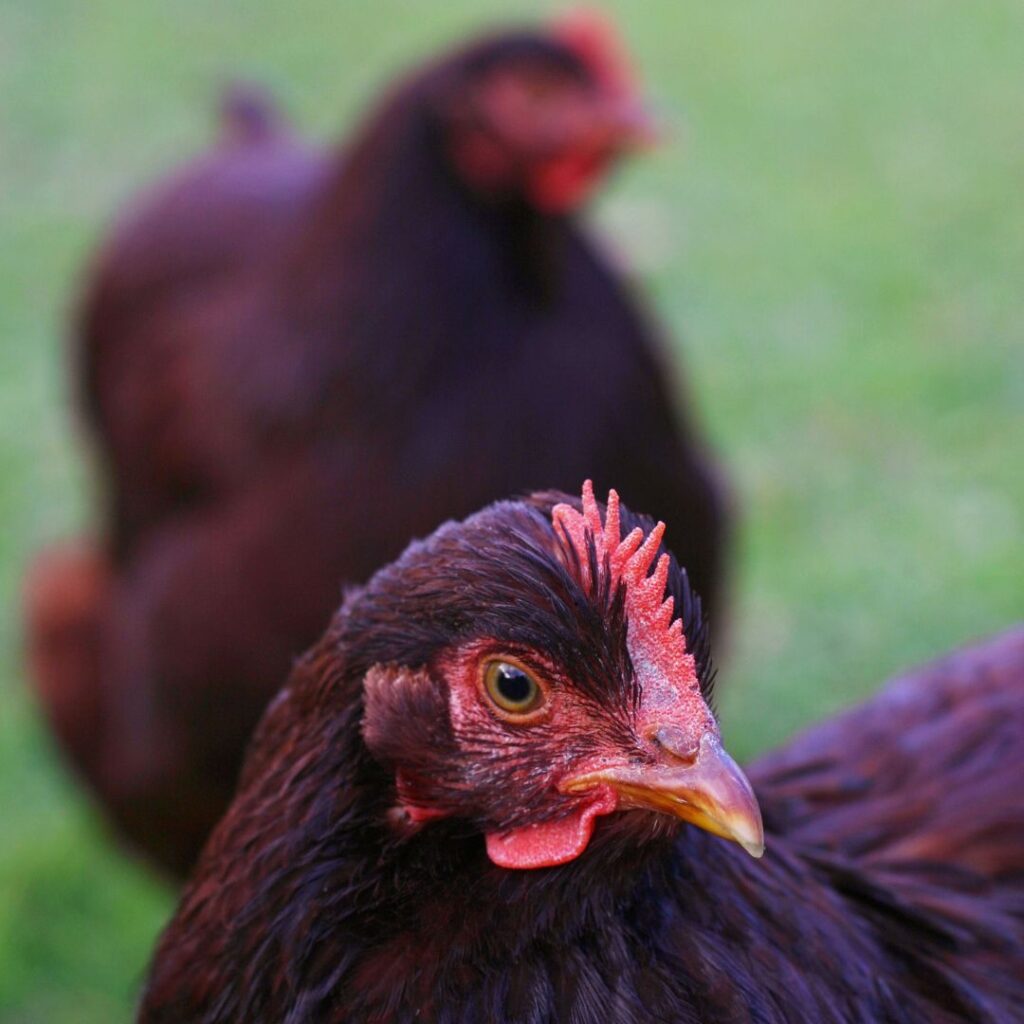
Rhode Island Red chickens are the most common chicken breeds raised by backyard chicken keepers in the U.S. They are hardy chicken breeds and are prolific brown egg layers in all kinds of weather.
- Origin – American, United States, Rhode Island
- Recognized by APA – Yes – 1904
- Comb type – Single
- Size – Hen – 6 1/2 lbs, Rooster – 8 1/2 lbs
- Eggs – Large, Brown, 200-280 eggs per year
- Personality – Active, curious, friendly, higher on the pecking order.
Welsummer
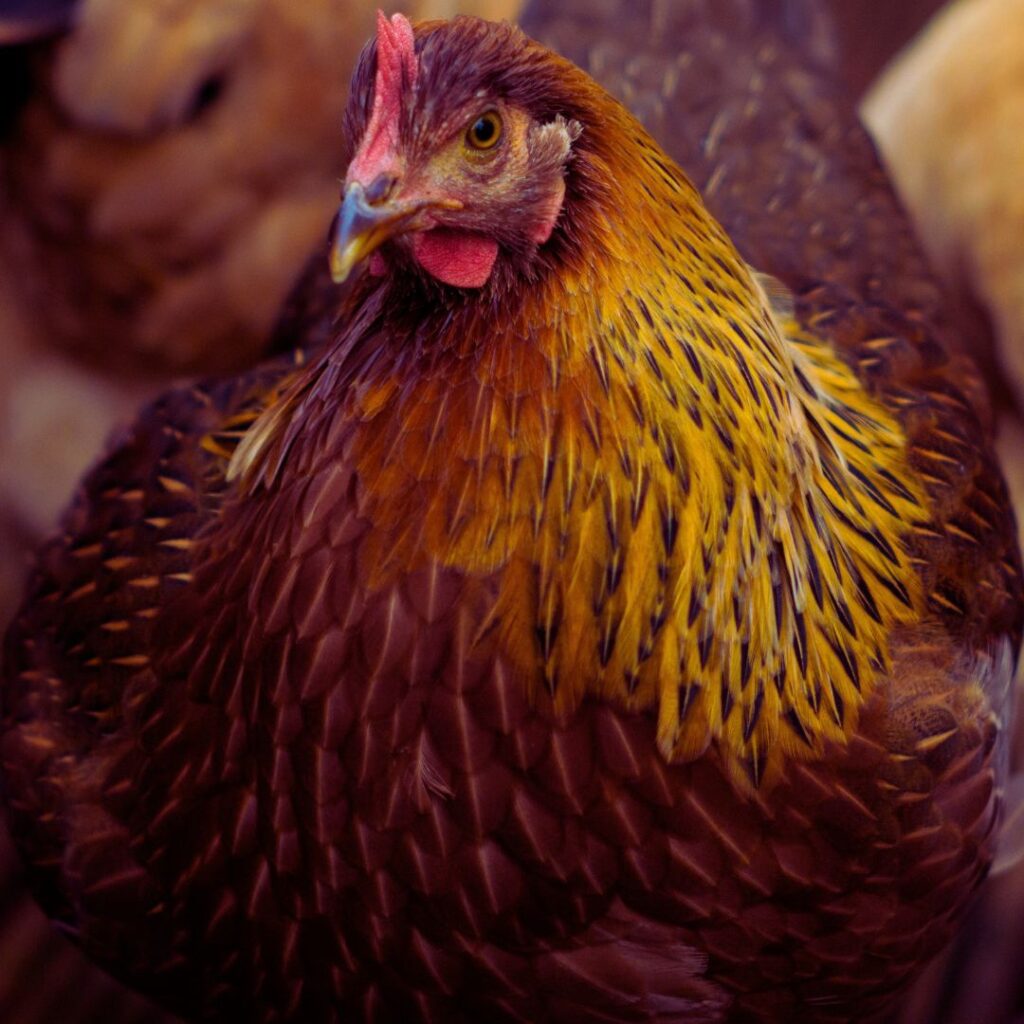
These chickens are owned by the Royal Family, King Charles!
- Origin – Continental – Holland
- Recognized by APA – Yes – 1991
- Comb type – Single
- Size – Hen – 6 lbs, Rooster – 7 lbs
- Eggs – Medium – Large, Dark Brown/ Chocolate colored eggs, 200-280 eggs per year
- Personality – Busy, gentle, affectionate, and docile.
White Leghorn

They are known in the chicken world as prolific layers of white eggs. These birds are used for commercial production for that reason. They are also extremely heat-tolerant chickens.
- Origin – Italy – Mediterranean
- Recognized by APA – Yes – 1874
- Comb type – Single
- Size – Hen – 4 1/2 lbs, Rooster – 6 lbs
- Eggs – Large – XLarge, White, 220-300 eggs per year
- Personality – Resourceful, aloof, very active birds who love to free range and eat weeds and bugs like ticks and grubs. However, when yet tolerate confinement well with a properly sized chicken coop.
5+ More Heat tolerant chicken breeds
Other heat-hardy breeds that do well in hot climates are:
- Aloha Chickens(still in development, aka a project bird, this bird is designed for areas like Arizona and Hawaii to be an exceptionally heat-tolerant chicken breed) This Aloha chicken is sad to be an extremely heat-tolerant chicken. (not heat resistant chickens)
- Cubalya
- Golden Phoenix
- Egyptian Fayoumi
- ISA Brown
- Minorca
- Sicilian Buttercup
- Speckled Sussex
- Sumatra chickens
- Whiting True Blue
- Game Birds, many were used as fighting chicken breeds (many years ago), are sturdy birds with wild bird roots and heat-hardy chickens.
Avoid These 5+ Breeds That Are NOT Heat-Tolerant Chickens
- Australorp
- Cornish Hens, Cornish Cross, Jumbo Cornish (traditionally used for raising meat birds)
- Jersey Giant
- Marans
- Orpingtons
- Wyandotte
5+ Heat Tolerant Chickens For Urban (City) Flocks
These breeds are heat-tolerant chickens as well as quiet birds. Raising chickens in urban areas can present different challenges.
Many city flocks need to stay confined, so extra care needs to be taken in ventilating the coop (for hot and cold weather), providing shade, cool water, and cooling stations, all creating a cooler environment.
These quiet chickens do well in hot climates; however, they still need proper care during extreme weather:
- Ameraucana
- Barred Plymouth Rock
- Brahma
- ISA Brown
- Rhode Island Red
- Other breeds that are quiet and urban-friendly
Dual Purpose Heat Tolerant Chicken Breeds
These heat-tolerant chicken breeds are good for egg production and meat birds.
- Barred Rock aka Barred Plymouth Rock
- Brahma
- Naked Neck aka Turken
- New Hampshire Red
- Rhode Island Red
- Buckeyes – Buckeyes are more likely to do well in cold temperatures; however, they adjust well to warm climates with proper shade, frequent cool water, and coop ventilation. These birds are fantastic for farm fresh eggs and meat.
How To Tell If Chickens Are Suffering From Heat Stress
Heat stress can be a serious problem for chickens, particularly during summer. If your chickens are suffering from any degree of heat stress, it’s imperative to address the issue immediately; otherwise, it can lead to further health issues and even death.
Knowing that your chickens are at risk of heatstroke is a serious matter.
All breeds are capable of getting heatstroke. It helps to understand a little bit about their body temperature:
A chicken’s body temperature typically ranges between 105-107 degrees (Fahrenheit). The hotter it gets, its core temperature climbs, leading to potential danger.
How Hot Temperatures Impact Your Chickens
Different breeds react differently when temperatures increase – while some might stop laying eggs around 90 degrees F, others may even perish given hotter environments. Read more about why chickens stop laying eggs here.
It is a natural body reaction for chickens to reduce and conserve energy in high temperatures; this is apparent when they cease egg production – typically around 90- 100 degrees F – to rest and save fluid levels.
Signs Of Heat Related Stress In Your Chickens
If you have a flock, especially with roosters, you may notice an attitude change in your bird long before they start showing health signs of heat issues.
This can be seen in aggression or general crankiness. Knowing your birds’ personalities can clue you into preventing more severe symptoms.
- Lethargy, not moving about much or labored movements, or sleeping often
- Labored breathing
- Panting or beaks open wider than usual
- Combs and Wattles are lighter to pale/ appear discolored
- Frequently lifting the wings away from the body or laying on the ground with wings spread out
- Erect feathers
- Loss of or decreased appetite
- Decrease in egg production
- Thin shells on eggs or no eggs at all
- Staggering, drunken chicken appearance
- Diarrhea
- Seizures, Convulsions
In An Emergency
Add some extra water to that kiddie pool and sit with your chicken, gently pouring cool (not ice cold) water over them.
Alternatively, sit in a shady area holding your bird and gently pour cool water from a bucket using a cup.
Soak a towel and hold your chicken in the cool towel for a few minutes, then replace it with another cool towel. Do this several times until you notice your chicken breathing easier.
Some chicken keepers have held their birds in the cool water up the chicken’s necks. NEVER EVER place your chicken’s head in the water!
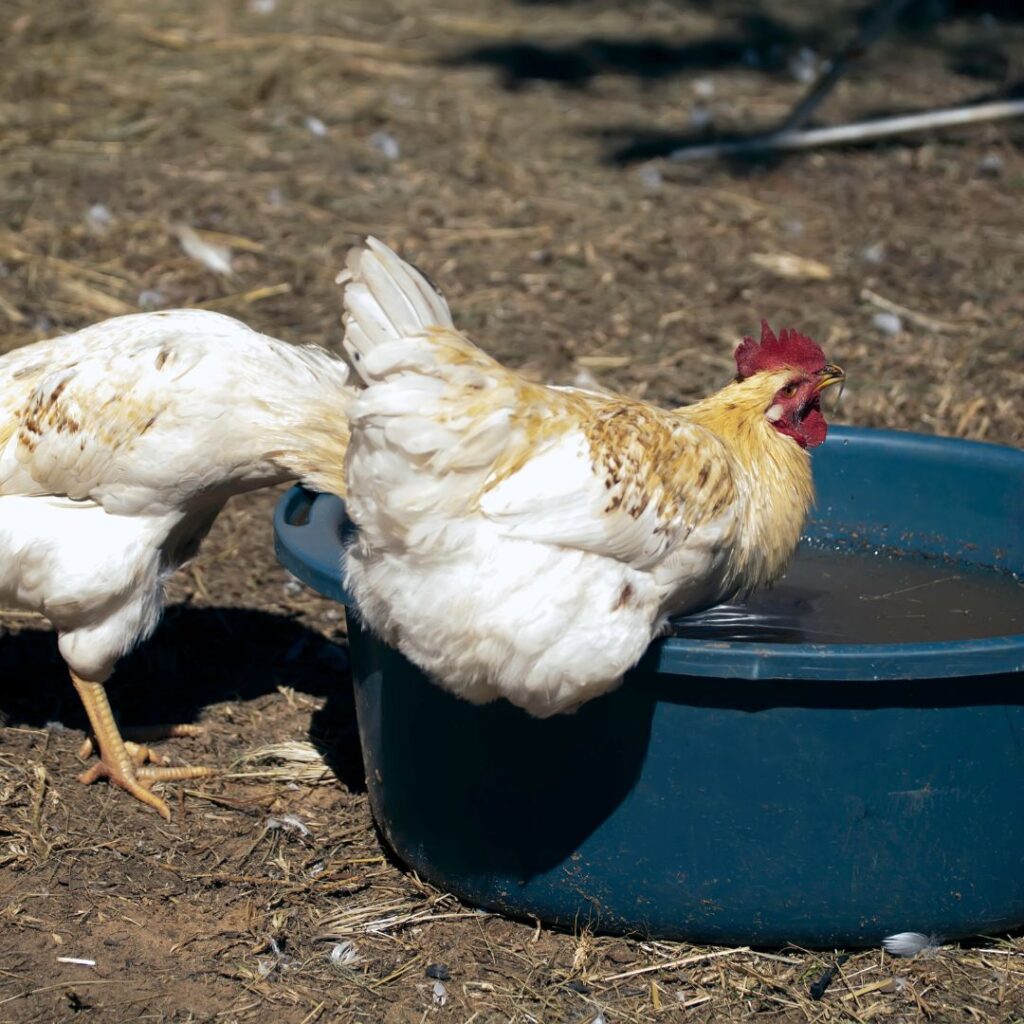
How To Keep Hot Chickens Cool During a Heat Wave
If your flock is normally confined to a run area, consider letting them out more often on the cool grassy areas of your yard, even a temporary free-range fencing system that can be moved around.
Choose shady areas of your yard under trees, near tall bushes that give off shade, and where chickens can hide.
Wherever they free-range, ensure a steady supply of cool fresh water.
How To Cool a Chicken Coop in the Summer; Heat Reduction Methods
Avoid the deep litter method; straw is excellent in the summer and can easily be raked, shoveled, or swept out of the coop, and as opposed to shavings, there is less dust.
The deep litter method is ideal for cooler temperatures as it aids in heating a coop naturally and safely.
Proper ventilation is critical year-round. Your goal is to keep moisture and humidity levels down, and in hot climates, you can increase ventilation with screen doors and screen windows and even temporarily add in a fan (check the fan’s safety first).
A more permanent solution to a fan would be installing an exhaust fan.
Clean coop regularly – decomposing waste will increase temperatures and ammonia levels in the coop, making for dangerous conditions.
Light-reflecting materials on the roof will help reduce indoor temperatures.
Shade is perfect for keeping the coop and run area cool. Locate coops near trees that have a lot of shade (leaves).

Tips for Keeping A Cool Chicken Run
- Constant supply of cool water, place in a shady area
- Locate near shady trees
- Plant climbing plants along fencing; this is a nice treat and will provide shade near the outer part of the run.
- Use Tarp or shade cloth
- Put a roof over the run
- Invest in a misting system
- Water yard area in the run, so it’s cool, not muddy
- A shallow basin of water or kiddie pool with fresh water daily (2-3″ deep) for chickens to cool their feet
- Dust bath, can add make-shift ice packs out of frozen water bottles and place them just below the surface to cool sand
- Toss Grass clippings in the chicken yard. Chickens that free range benefit from that cool green grass underfoot, so it makes sense to share clipping from a freshly cut lawn in the run area.

Tips For Feeding Your Chickens In Hot Weather
Store feed in a cool dark place, feed in a hot shed will quickly get moldy, buggy, and spoil, making your chicken ill.
An Insulated Waterer will keep water cool longer. You want to keep a steady supply of cool water in the chicken coop and the chicken yard (remember, the free-range birds need lots of water too).
Add Iced Cubes or Frozen Iced Rings (use a bundt pan) in water to keep it cool longer.
Freeze treats, and bags of frozen fruits and veggies in your freezer from the garden, and toss a couple of handfuls in a day; the cool treats will help reduce their body heat.
Freeze feed and treats in a container of water, and place them in a shady area.
Foods to avoid in hot weather
Avoid high-fat foods; these will take more energy for your bird to digest and increase their body heat.
Refrain from giving your chickens foods like sunflower seeds and corn or flock blocks with those ingredients included.
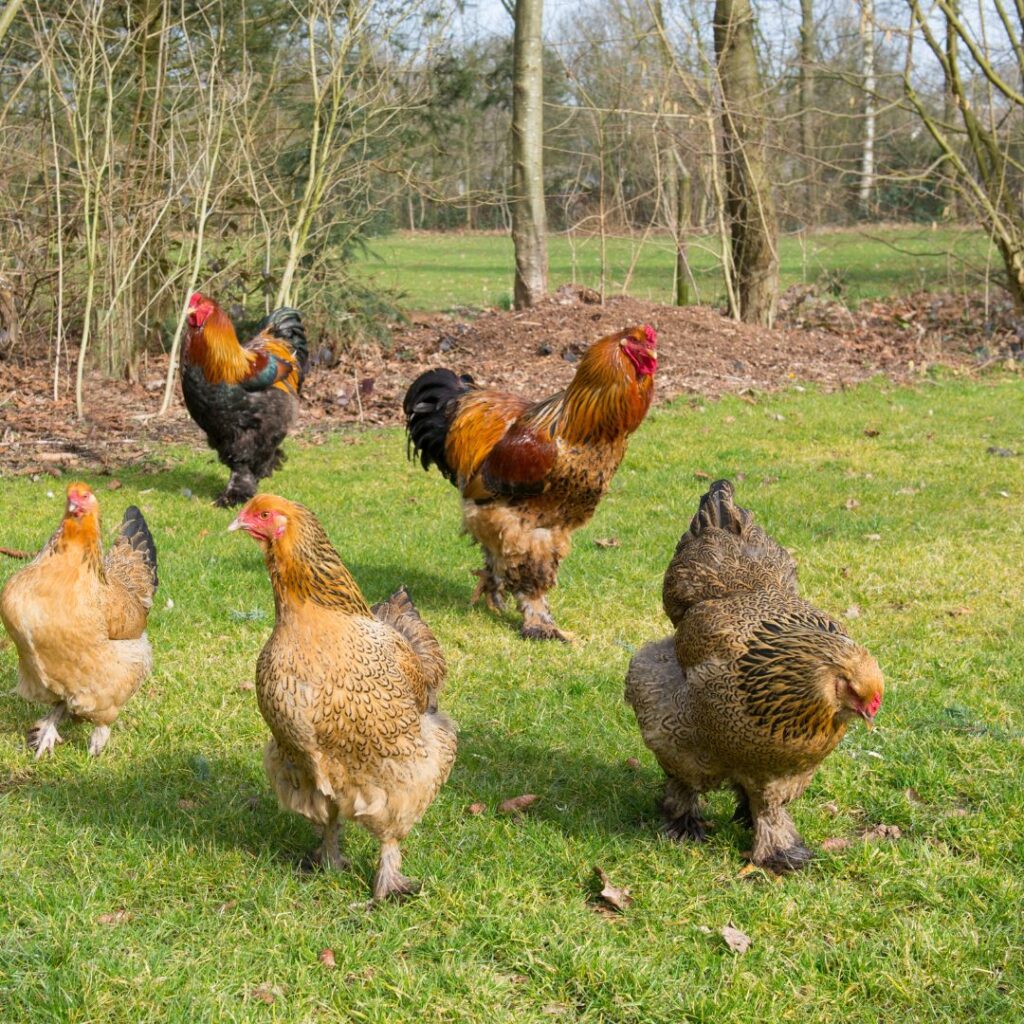
7+ Best Chicken Breeds That Do Well In Hot And Cold Climates
These chickens are perfect for parts of the U.S. that see drastic weather shifts throughout the year. This list is only a sampling of the many breeds that are both cold-hardy and heat-hardy chicken breeds.
- Brahma
- Buckeyes
- Delaware
- Easter Egger
- New Hampshire
- Rhode island red
- Whiting True Blue
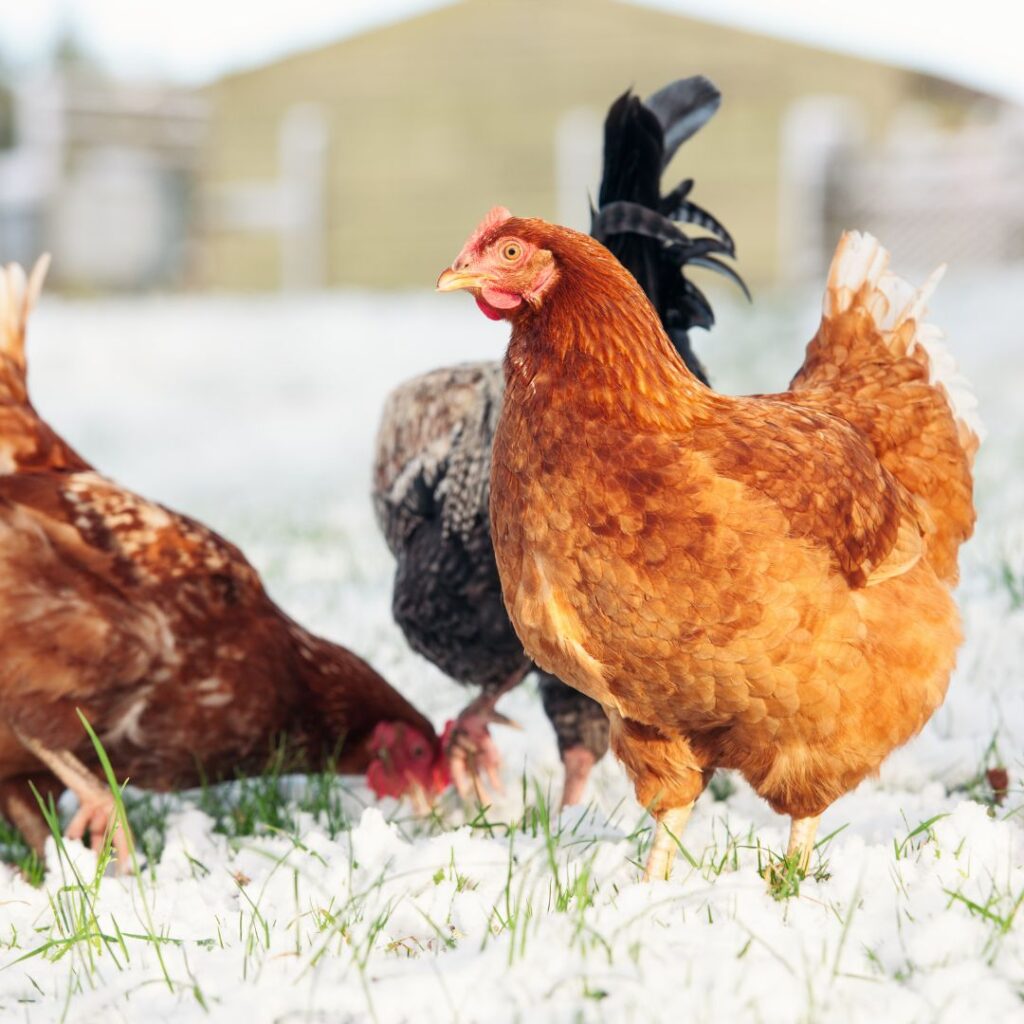
7+ Best Chicken Breeds For Cold Climates
These are some of our top picks for cold winters, although many also do well in both the heat and frigid temps.
- Australorp
- Buckeye
- Chantecler
- Cochin
- Dominique
- Jersey Giant
- Silkie
- Other Breeds That Are Cold Hardy
- How to prepare your flock for the winter
- Read about chickens laying eggs in the winter (year-round) here.
7+ Best Egg Laying Chicken Breeds
- Ameraucana
- Australorp
- Brahma
- Easter Egger
- Golden Comet
- Jersey Giants (Black Giants)
- Leghorn
Read more about the 15 Best Egg Laying Breeds
Summary:
Caring for chickens in hot climates can be easy if you understand what qualities make a heat-tolerant breed and how best to care for them when temperatures rise.
Choosing appropriate breeds; providing adequate shade; ensuring proper ventilation; keeping plenty of clean water available; and adding electrolytes where necessary will all help ensure that your chickens stay healthy and happy even when summer days are scorching.
With this knowledge keeping chickens in hot climates can be done successfully.


